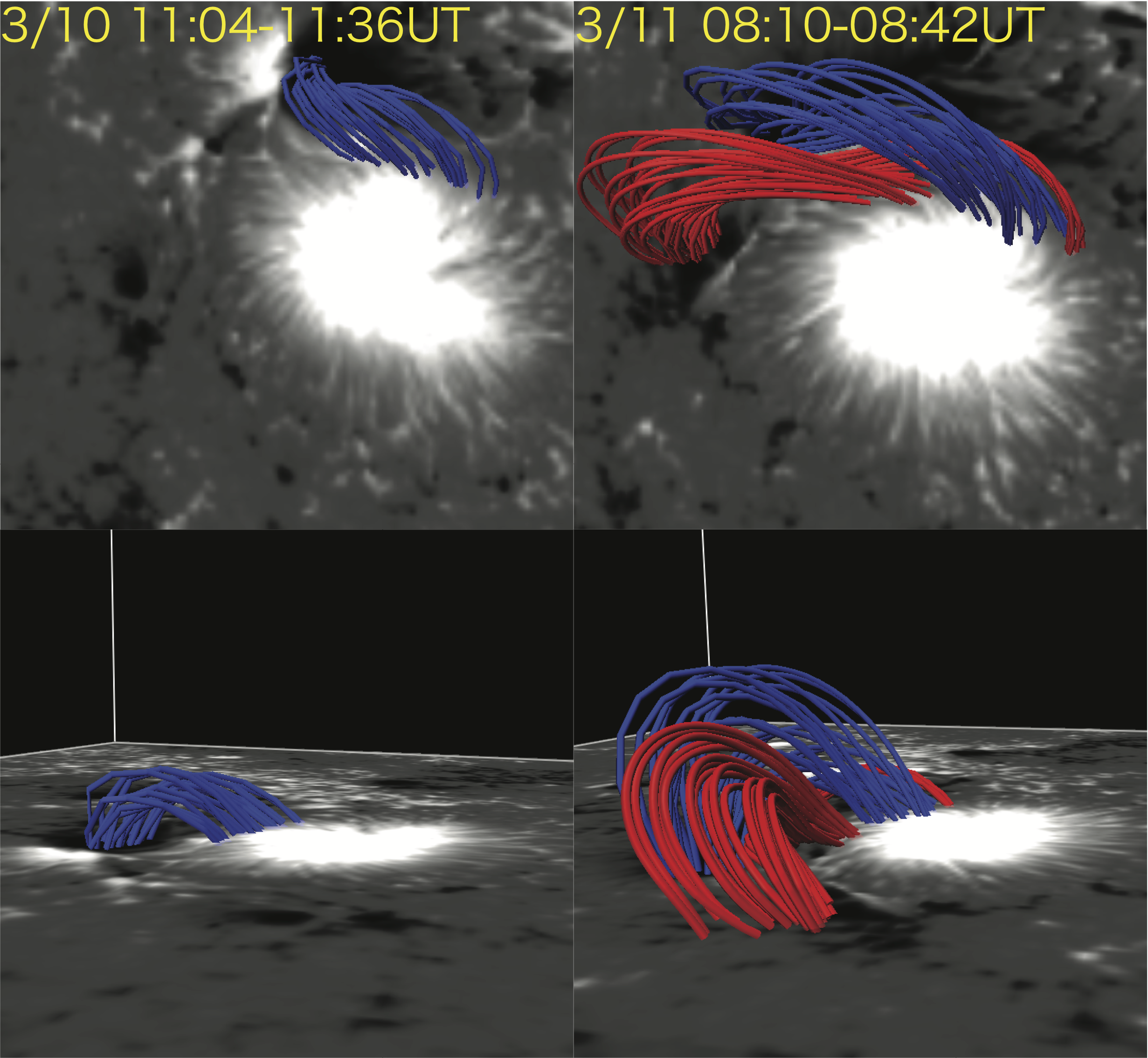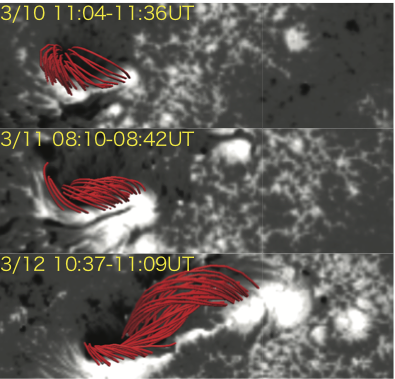NLFFF calculations of the solar coronal magnetic field based on Hinode observations
JAXA Supercomputer System Annual Report April 2020-March 2021
Report Number: R20EU0912
Subject Category: Space and Astronautical Science
- Responsible Representative: Yoshifumi Saito,, Institute of Space and Astronautical Science, Department of Solar System Sciences
- Contact Information: Toshifumi Shimizu(shimizu.toshifumi@jaxa.jp)
- Members: Yusuke Kawabata, Toshifumi Shimizu, Takahiro Hasegawa
Abstract
Our study focuses on understanding of the mechanism responsible for the occurrence of the solar flares. We derive 3D magnetic field structure in the corona by performing a 3D magnetohydrodynamics simulation using vector magnetic field maps mainly acquired with the Hinode spacecraft. We investigate 3D magnetic field structure formed in the solar atmosphere responsible for the occurrence of solar flares.
Reference URL
Please refer to 'ひのでプロジェクトのホームページ:TOP PAGE'.
Reasons and benefits of using JAXA Supercomputer System
We perform 3D magnetohydrodynamics numerical simulations by using vector magnetic field data acquired with the Hinode spacecraft in order to derive 3D magnetic field structures in the solar corona. We need large computational resource in order to perform three-dimensional magnetohydrodynamics simulations.
Achievements of the Year
For understanding the trigger and energy build-up processes of solar flares, it's essential to evaluate the temporal evolution of photospheric magnetic field distributions and its coronal consequences. No reliable observationations of the coronal magnetic fields drive us to extrapolate the magnetic field lines from the photosphere to the corona. Reliable measurements of magnetic field at the photosphere are used as the boundary condition to extrapolate the field lines to the corona under the assumption of force-free field. This non-linear force free field (NLFFF) modeling is a valuable method to investiagate how the energy is stored and released in solar flares. This year we applied the method for Hinode's spectro-polarimetric observations in two magnetic concentrations which showed similar evolutions of magnetic field (i.e., flux emergence near to a pre-existing sunspot) and produced solar flares in different manners. The method allowed us to find new connectivities forming between emerging and pre-existing magnetic patches in the both regions. Tthe magnetic field is locally and strongly twisted in one region (Fig.1), whereas in the other region the shear motion of the emerging flux stretched the magnetic field and developed a long polarity inversion line (Fig.2). These differences in topological evolution may be a factor for creating the different nature of flare occurrences in these regions.

Fig.1: The top views (top) and the oblique views (bottom) of the flare-productive region 1. Background grayscale is the photospheric vertical magnetic field derived by the polarimetric observations of the Hinode spacecraft. Red and blue lines visualize the coronal magnetic field extrapolated with the NLFFF method.

Fig.2: The top views of the flare-productive region 2. Background grayscale is the photospheric vertical magnetic field derived by the polarimetric observations of the Hinode spacecraft. Red lines visualize the coronal magnetic field extrapolated with the NLFFF method.
Publications
- Peer-reviewed papers
Hasegawa, T., Shimizu, T., Temporal Behaviors of Magnetic Helicity Injections by Self and Mutual Sunspot Rotations, The Astrophysical Journal, Submitted
Usage of JSS
Computational Information
- Process Parallelization Methods: MPI
- Thread Parallelization Methods: N/A
- Number of Processes: 1 - 144
- Elapsed Time per Case: 8 Hour(s)
Resources Used(JSS2)
Fraction of Usage in Total Resources*1(%): 0.03
Details
Please refer to System Configuration of JSS2 for the system configuration and major specifications of JSS2.
| System Name | Amount of Core Time(core x hours) | Fraction of Usage*2(%) |
|---|---|---|
| SORA-MA | 0.00 | 0.00 |
| SORA-PP | 173.40 | 0.00 |
| SORA-LM | 0.00 | 0.00 |
| SORA-TPP | 16,214.21 | 1.53 |
| File System Name | Storage Assigned(GiB) | Fraction of Usage*2(%) |
|---|---|---|
| /home | 25.61 | 0.02 |
| /data | 254.85 | 0.00 |
| /ltmp | 5,208.34 | 0.44 |
| Archiver Name | Storage Used(TiB) | Fraction of Usage*2(%) |
|---|---|---|
| J-SPACE | 0.00 | 0.00 |
*1: Fraction of Usage in Total Resources: Weighted average of three resource types (Computing, File System, and Archiver).
*2: Fraction of Usage:Percentage of usage relative to each resource used in one year.
Resources Used(JSS3)
Fraction of Usage in Total Resources*1(%): 0.01
Details
Please refer to System Configuration of JSS3 for the system configuration and major specifications of JSS3.
| System Name | Amount of Core Time(core x hours) | Fraction of Usage*2(%) |
|---|---|---|
| TOKI-SORA | 0.00 | 0.00 |
| TOKI-RURI | 2.32 | 0.00 |
| TOKI-TRURI | 14,825.28 | 1.19 |
| File System Name | Storage Assigned(GiB) | Fraction of Usage*2(%) |
|---|---|---|
| /home | 19.35 | 0.01 |
| /data | 191.54 | 0.00 |
| /ssd | 190.73 | 0.10 |
| Archiver Name | Storage Used(TiB) | Fraction of Usage*2(%) |
|---|---|---|
| J-SPACE | 0.00 | 0.00 |
*1: Fraction of Usage in Total Resources: Weighted average of three resource types (Computing, File System, and Archiver).
*2: Fraction of Usage:Percentage of usage relative to each resource used in one year.
JAXA Supercomputer System Annual Report April 2020-March 2021


